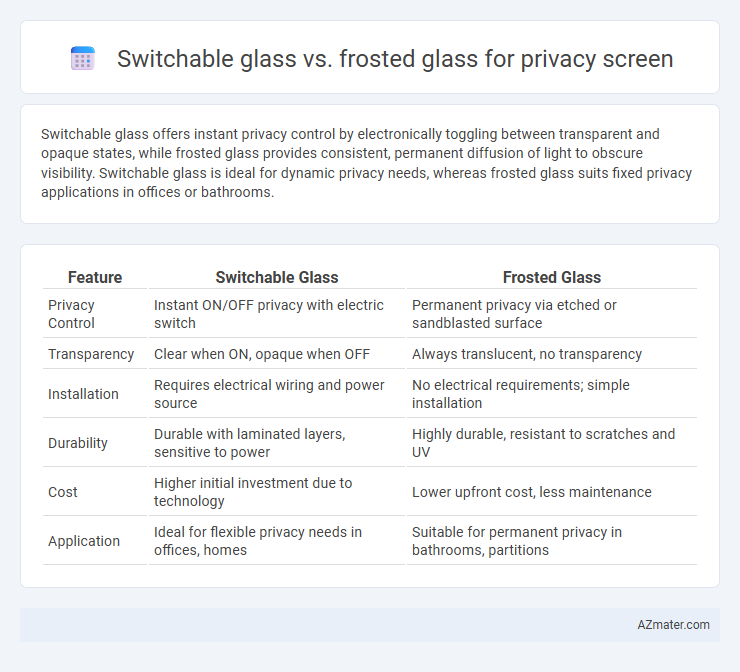Switchable glass offers instant privacy control by electronically toggling between transparent and opaque states, while frosted glass provides consistent, permanent diffusion of light to obscure visibility. Switchable glass is ideal for dynamic privacy needs, whereas frosted glass suits fixed privacy applications in offices or bathrooms.
Table of Comparison
| Feature | Switchable Glass | Frosted Glass |
|---|---|---|
| Privacy Control | Instant ON/OFF privacy with electric switch | Permanent privacy via etched or sandblasted surface |
| Transparency | Clear when ON, opaque when OFF | Always translucent, no transparency |
| Installation | Requires electrical wiring and power source | No electrical requirements; simple installation |
| Durability | Durable with laminated layers, sensitive to power | Highly durable, resistant to scratches and UV |
| Cost | Higher initial investment due to technology | Lower upfront cost, less maintenance |
| Application | Ideal for flexible privacy needs in offices, homes | Suitable for permanent privacy in bathrooms, partitions |
Introduction to Privacy Screens: Why They Matter
Privacy screens are essential for creating discreet and secure environments in offices, homes, and public spaces. Switchable glass offers dynamic opacity control through electrical activation, enabling instant privacy with the flick of a switch. Frosted glass provides a static, translucent surface that diffuses light while obscuring visibility, making it a cost-effective but less versatile privacy solution.
What is Switchable Glass?
Switchable glass is an innovative privacy screen technology that uses liquid crystal molecules embedded between glass layers to toggle between transparent and opaque states when an electric current is applied. This smart glass allows instant control over visibility, providing privacy on demand without sacrificing natural light. Unlike frosted glass, which is permanently translucent, switchable glass offers dynamic functionality, making it ideal for modern office partitions, conference rooms, and residential spaces.
What is Frosted Glass?
Frosted glass is a type of glass treated with acid or sandblasting to create a translucent, matte finish that diffuses light while obscuring visibility, ensuring privacy without blocking natural light. Commonly used in office partitions, bathroom windows, and doors, frosted glass provides a permanent privacy solution. Unlike switchable glass that changes opacity electronically, frosted glass maintains a fixed privacy level and offers a cost-effective, low-maintenance option.
How Switchable Glass Works
Switchable glass operates using an electric current that alters the alignment of liquid crystal molecules embedded between two glass panes, switching the glass from opaque to transparent instantly. When powered, the liquid crystals align to allow light to pass through, providing clear visibility; when the power is off, the crystals scatter light, creating a frosted, privacy-enhancing effect. This technology delivers dynamic privacy control, unlike static frosted glass that permanently diffuses light and obscures vision.
How Frosted Glass Works
Frosted glass provides privacy by creating a textured surface that diffuses light and obscures vision without blocking natural light completely. This effect is achieved through sandblasting or acid etching, which alters the glass surface to scatter incoming light and prevent clear images from passing through. Unlike switchable glass, frosted glass offers a permanent privacy solution without the need for electrical power or control systems.
Visual Privacy Comparison
Switchable glass offers dynamic control over privacy by instantly changing from transparent to opaque with an electric signal, providing on-demand visual privacy. Frosted glass provides a constant level of privacy by diffusing light and obscuring views, but lacks the ability to switch between clear and obscured states. For environments where adaptable privacy is essential, switchable glass outperforms frosted glass by combining transparency and privacy in a single solution.
Installation and Maintenance Differences
Switchable glass requires professional electrical installation to integrate its smart film technology, involving wiring and control systems, whereas frosted glass can be installed using standard glazing methods without electrical components. Maintenance for switchable glass involves periodic checks of the electronic components and power supply, while frosted glass only needs regular cleaning to maintain its privacy effect. Switchable glass offers dynamic opacity control but demands higher initial setup and potential repairs; frosted glass provides a static privacy solution with minimal maintenance concerns.
Cost Analysis: Switchable vs Frosted Glass
Switchable glass typically costs between $70 and $120 per square foot, significantly higher than frosted glass, which ranges from $10 to $30 per square foot, making frosted glass more budget-friendly for large-scale privacy applications. Installation and maintenance expenses also contribute to the total cost of switchable glass, which requires electrical components and occasional servicing, while frosted glass demands minimal upkeep. When factoring in energy efficiency, switchable glass can reduce cooling costs by controlling solar heat, potentially offsetting its higher initial investment over time.
Design Flexibility and Aesthetics
Switchable glass offers superior design flexibility by allowing users to toggle between transparency and opacity, creating dynamic privacy solutions that adapt to varying needs and lighting conditions. Frosted glass provides a consistent, diffuse appearance that enhances privacy while maintaining a soft, elegant aesthetic ideal for spaces seeking a timeless, uniform look. The choice between switchable and frosted glass depends on whether adjustable opacity or a permanent decorative effect better suits the design and functional requirements of the space.
Choosing the Right Privacy Screen for Your Space
Switchable glass offers dynamic privacy control by electronically toggling between transparent and opaque states, ideal for versatile environments needing adaptable privacy levels. Frosted glass provides a consistent, static privacy solution with a translucent, textured surface that diffuses light while obscuring visibility, making it suitable for permanent installations. Selecting the right privacy screen depends on factors like desired privacy flexibility, budget, and the aesthetic integration within office, residential, or commercial spaces.

Infographic: Switchable glass vs Frosted glass for Privacy screen
 azmater.com
azmater.com